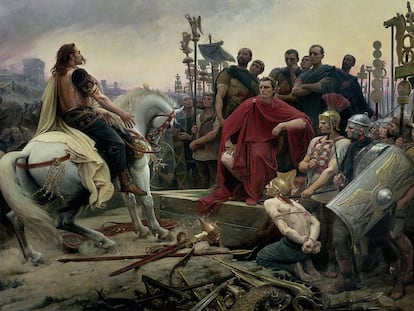Kill, die and rise in the legions: London’s British Museum revisits the life of the imperial Roman army with a spectacular exhibition
The show includes the only surviving rectangular shield and a breastplate from the Varo massacre, among other exceptional artists
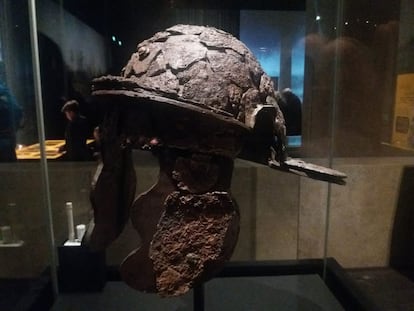
Enlist in the legions, they say; you’ll see the world, they say. Perhaps it is not unusual to pass between the columns of the British Museum repeating the Asterix the Legionary phrase while walking at a military pace, clutching one’s umbrella like a pilum and looking for one’s gladius, or sword. One arrives to the exhibition Legion: life in the Roman Army, which opened this month in London (Londinum) and can be visited through June 23 (non deesset eam! or rather, don’t miss it!), to high expectations. You are to be forgiven for being nervous, eager, even. The legions at the British, wow, it’s like going on a date with Maximus Decimus Meridius, the general from Gladiator, and his troops in the forests of Germania. So, after flashing your ticket (you had to pre-book, the exhibition is sold out) and muttering to yourself the motto of the legions of the North (“strength and honor”), you enter the museum’s Sainsbury galleries into the tempestuous and exciting world of the Roman soldiers, wow!
The exhibition, which consists of more than 200 archaeological objects (from museums and private collections alike), some of them truly unique and sensational, comes accompanied by a voluminous catalogue by its curator, Richard Abdy or the British Museum, who proposes an extensive and exciting journey through the experience of serving in the ranks of the forces of ancient Rome, and the evolution of its impressive war machine, with which it brought the world to its knees. All the while, you are accompanied by the haunting recorded audio of a hundred marching sandals and the soaring shadows of the eagle, the primary and most revered standard of the legions. Throughout the galleries, drawings, graphics and scenographic elements are displayed next to archaeological objects to better enhance understanding and provide atmosphere.
The exhibition, of which Vegetius would surely approve, is rounded out by activity areas (which should delight children and no few adults) where you can try on a Roman helmet, raise a shield and even experience the smell of campfire or sweat after a long day’s march. You can even see the contents of a latrine (!) One may also measure oneself to see if one would have been admitted to the legions in the first place: if you were taller than 5 feet 6 inches, you were in. The maximum age was 35. Another requirement was to have at least one testicle.
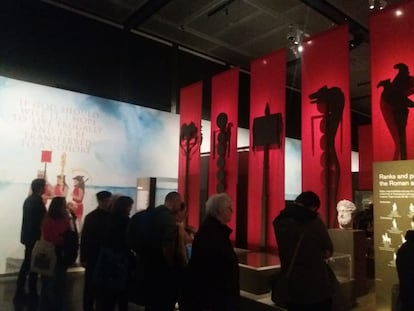
Among the most spectacular items on display are a pair of shooting targets (one, a human-shaped wooden item showing the mark of swords, and the other, an ox skull pierced by projectiles), a military sandal (caliga) and boot (calceus) (and a sock! It was worn with the sandals), a large cornu (command horn), a dragon standard (draco) carried, of course, by the draconarius, and the extravagant cavalry parade masks; there are even some precious swords with their scabbards. Absolutely extraordinary is the nearly complete segmented armor found on the battlefield of the Varus (Kalkriese) legions disaster, testament to the Roman army’s greatest defeat — three legions, the XVII, XVIII and XIX, 20,000 soldiers in total, completely annihilated in a great ambush by the Germans that resulted in savage human sacrifices (enlist, they say!) and a scutum, the iconic rectangular shield of the legionaries, from Dura Europos (Syria) and which is the only one of its kind that has been preserved. A wall drawing shows a group of legionaries performing the famous turtle with their shields.
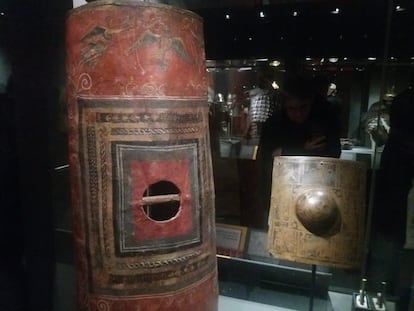
Also to be admired, in a wonderful gallery of weapons, is a piece of armor with two types of scales (indicative that it had been repaired) from Hadrian’s Wall; different styles helmets of that show an evolution towards higher degrees of protection, some with graffiti proclaiming the names of their owners (on one, there are four, suggesting up to a hundred years of use — recycling!), and one (the Meyrick helmet) with unusual Celtic decorations, testimony to its use by some auxiliary unit of those peoples. Also noteworthy is the scaled armor of a horseman’s steed (clibanarios or catafractos) and a specimen made from crocodile skin, one of the highly curious artifacts that the British Museum typically exhibits in its Roman galleries.
But likely the most striking and moving pieces are the skeletons on display. The most impressive, that of a soldier found at Herculaneum who is wearing a military belt with sword and dagger ad exercitum manere (it is not clear whether he was participating in an attempt to evacuate civilians cornered by the eruption of Vesuvius or whether he was caught on a bad day, really). Those of two other soldiers, apparently killed and thrown into a well at Canterbury with their swords and boots spiked, can also be seen. Another skeleton exhibited (to illustrate that cowardly soldiers and prisoners of war were sometimes executed in this manner) is that of a crucified man, who had a nail still driven into his ankle. The show is a reminder that for all the enthusiasm they may provoke, Roman troops acted with savagery and rapacity, enslaving and often acting as occupying and policing forces. To paraphrase Calgacus, as quoted by Tacitus, they made a desert and called it peace.
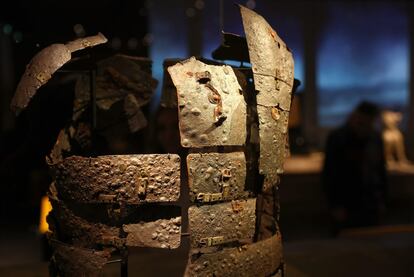
Given the extreme difficulty of covering the whole of a very long Roman military history (roughly a millennium, from 500 BCE to 500 CE), the exhibition is limited to two centuries, the period of the first emperor Augustus (who reigned from 27 BCE to 14 CE), under which the idea of the career soldier was established (until that point, the legions were formed and disbanded for specific campaigns; after this point, they were to be a standing army), to Maximinus Thrax, Maximinus the Tracian (235-238 CE), the first of the “soldier emperors” of the third century, which can be seen as the highest promotion a soldier can achieve. If Augustus was a giant for his deeds, Maximinus, the first emperor of Barbarian origin and the first who never set foot in the city of Rome, was a giant for his size (8 feet 6 inches).
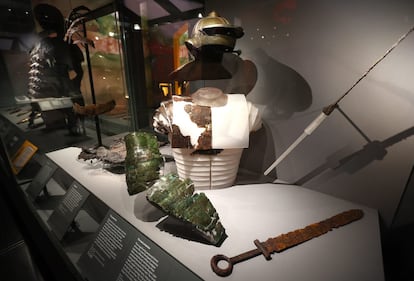
The exhibition details how one enlisted, the options available (you could be a legionary, the first class option, or auxiliary, or marine of the naval forces), the training (very hard), the combat techniques (“knowledge of the military discipline nourishes the audacity to fight,” according to Vegetius), the equipment (each had to carry 59 pounds, the shield alone weighed 11), the ranks (the centurions were the backbone of the legions), the rewards, the punishments (terrible, including the decimatio, the decimation of troupes who were disgraced in battle), health, the cavalry (the most successful horseman perhaps being Tiberius Claudius Maximus, who apprehended the Dacian king Decabalus), the camps (fragments of tents and pickaxes are on display) and forts, and the way in which one, if one survived (only half of all soldiers did), was eventually discharged after 25 years of service. On display too is the oldest example of a retirement certificate, granted by Emperor Claudius to a Thracian who served in the Misenium navy and who answered to the phenomenal name Sparticus Dipscurtus. Citizenship was granted to him, his wife and children.
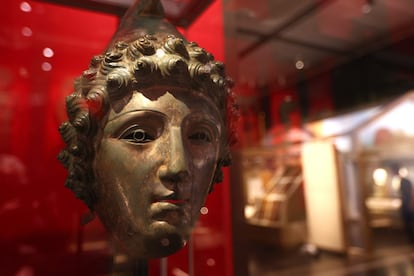
A central area is devoted to the terrible experiences of battle, a vortex of violence represented by images of fighting, clattering weapons, pilums flying overhead and a ballista, one of those artillery machines (generically called a storm) with which Russell Crowe’s General Maximus unleashed hell in Germania. In another area of the exhibition, a statue of a molosser dog seems to be a nod to our favorite fictional Roman soldier, with permission of Marcellus Gallio from The Robe and Marcus Flavius Aquila of The Eagle of the Ninth. Messala was surely the better athlete.
To guide us through this history of legions and wars, the exhibition, the first to be dedicated by the British Museum to the Roman army, presents different military men, whom we see face to face, represented mainly by their funerary monuments. Here stands Quintus Petilius Secundus, of the XV legion Primigenia, clutching his pilum; Firmus Ecconis of a strong auxiliary cohort from Raetia, with his characteristic oval shield and javelin; the standard-bearer Pintaius Pedicili, who carried one of the insignia of the auxiliary cohort V Asturum; the young and ill-fated centurion Marcus Favonius Facilis and the veteran Marcus Caelius, the primus pilus, the only centurion of the first cohort (milaria) of a legion, the one that carried the eagle, with its identifying and feared vine rod (vitis) and loaded with decorations. The centurions of his class were paid 80 times more than a basic legionary, and that, without triennia.
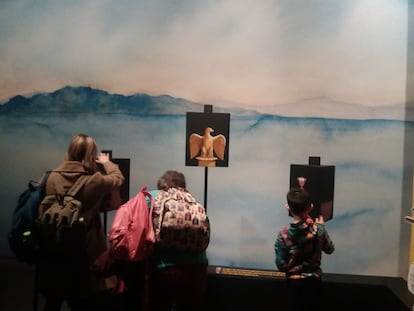
We are invited to follow along particularly closely with the careers of two military men who exemplify the experience of being a soldier of Rome: Apion and Claudius Terentianus, both from the second century, and both documented by their letters home, from which significant excerpts are presented. Terentianus was initially rejected from the legions due to a lack of recommendations and had to start out in the navy, a less glamorous posting. Finally, he ended up as a legionary facing the Parthians. Children can also follow the career of a third solider, who is illustrated by cartoon. Rattus, a friendly auxiliary rat (“second-rate weapons and shit pay”) created by the authors of the series The Horrible History of the World by Terry Deary and Martin Brown.
Among the curiosities mentioned in the exhibition are the fact that there were units of Roman cavalry who were mounted on camels (dromedarii), that mobile hospitals were invented in the legions, that soldiers were given an identifying tattoo (from the third century on, this became a lead plate hanging from one’s neck), that Roman medicine was capable of curing a soldier who had suffered intestinal evisceration, or that sailors, despite their low prestige, were used for special operations (Nero had them sink his mother’s boat and then, since she didn’t drown, assassinate her); they helped to build Hadrian’s Wall, and created several legions themselves.
The exhibition dismantles some common misconceptions, such as that there was some logic or order in the numbering of the legions, or that the rowers of the Roman galleys were chained together. It also explains how legionaries advanced by trampling fallen enemies with their spiked footwear, which were like rugby boots with studs. If you’ve ever been in the middle of a particularly tight melee, you can imagine, with the addition of gladiuses and a lot of nastiness, what the advance of the legions, the famous meat grinders, was like. The variation in the equipment of the soldiers was vast, you didn’t see the kind of uniformity on display in the battalions of Trajan and Marcus Aurelius.
Attention is paid (o tempora!) to the presence of women in the world of the legions, and thus we find Agrippina the Great, who convinced the soldiers not to abandon a bridge in Germania, thus saving it, and the Empress Julia Domna, who accompanied her husband Septimius Severus, receiving the name of mater castrorum, camp mother, and who apparently had a lifelong trademark hairstyle in the field. On display are some of the famous letters from the Vindolanda fort (including an invitation to a party) that shed light on the role of women in the barracks, in this case, on the borders of the empire (next to Hadrian’s Wall). A group of women who tortured prisoners in Trajan’s battalion may have been vengeful Roman war widows. Perhaps we are lacking mentions of bitter enemies of Rome such as Buodica, the warrior queen of the Iceni in the uprising of the British tribes, or Veleda, who was a Germanic princess and seer who encouraged the Bavarian revolt in the year of the four emperors, CE 69. A cavalry parade mask with the features of an Amazon introduces the concept — suggests the exhibition — that perhaps its wearer adopted a transgender identity during battles. That, of course, was not in Asterix the Legionary.
Sign up for our weekly newsletter to get more English-language news coverage from EL PAÍS USA Edition
Tu suscripción se está usando en otro dispositivo
¿Quieres añadir otro usuario a tu suscripción?
Si continúas leyendo en este dispositivo, no se podrá leer en el otro.
FlechaTu suscripción se está usando en otro dispositivo y solo puedes acceder a EL PAÍS desde un dispositivo a la vez.
Si quieres compartir tu cuenta, cambia tu suscripción a la modalidad Premium, así podrás añadir otro usuario. Cada uno accederá con su propia cuenta de email, lo que os permitirá personalizar vuestra experiencia en EL PAÍS.
¿Tienes una suscripción de empresa? Accede aquí para contratar más cuentas.
En el caso de no saber quién está usando tu cuenta, te recomendamos cambiar tu contraseña aquí.
Si decides continuar compartiendo tu cuenta, este mensaje se mostrará en tu dispositivo y en el de la otra persona que está usando tu cuenta de forma indefinida, afectando a tu experiencia de lectura. Puedes consultar aquí los términos y condiciones de la suscripción digital.
More information
Archived In
Últimas noticias
Welcome to the post-religion era: The idea of Christianity as the absolute truth has become obsolete
‘I thought you would like it’: The risky sexual practice popularized by TV shows and TikTok
The digitalization of tourism: ‘They promise experiences and gave us the worst possible one’
Mexican peso defies uncertainty with forecasts of a new period of stability in 2026
Most viewed
- Sinaloa Cartel war is taking its toll on Los Chapitos
- Reinhard Genzel, Nobel laureate in physics: ‘One-minute videos will never give you the truth’
- Oona Chaplin: ‘I told James Cameron that I was living in a treehouse and starting a permaculture project with a friend’
- Why the price of coffee has skyrocketed: from Brazilian plantations to specialty coffee houses
- Silver prices are going crazy: This is what’s fueling the rally


